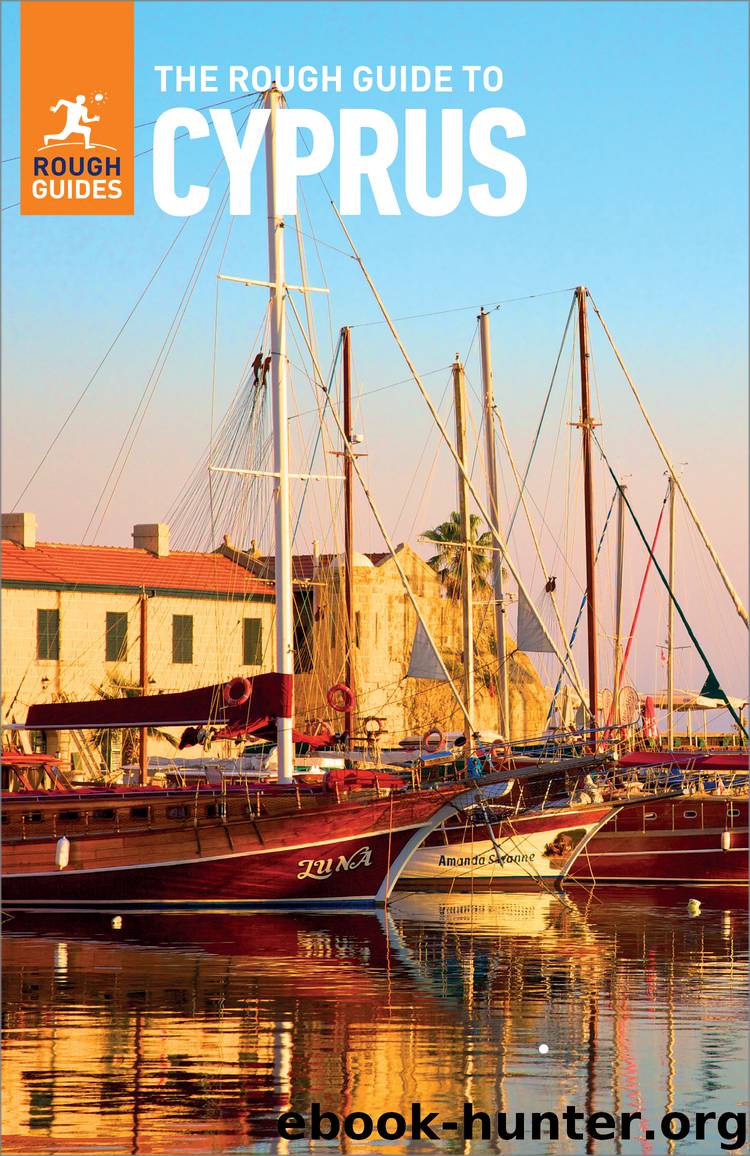The Rough Guide to Cyprus (Travel Guide eBook) by Rough Guides

Author:Rough Guides
Language: eng
Format: epub
Tags: Travel, Cyprus
Publisher: Apa Publications
Published: 2019-04-30T09:15:07+00:00
South of Polis
South of Polis is an upland area dotted with villages and vineyards, easily accessible from the main B7 Polis to Pafos road and from the F723. Though its numerous villages might not be worth a specific visit, they certainly merit looking out for, or making a short detour to.
Steni
The first thing you notice in STENI, 7km south of Polis on the F723, is the war memorial, which stretches along the main street. Rather than the usual statues representing the fallen, to be found in most Cypriot villages, it consists of a simple wall with parts dedicated in turn to the two World Wars, the campaign against the British, and the Turkish invasion of 1974. Directly across the road is the Museum of Local Life (daily 10am–4pm: free, though donations welcome), heaving with artefacts that cover virtually every aspect of existence – rural life, local crafts, domestic equipment, musical instruments, coins – from 1800 to the end of World War II. Many Cypriot villages have such rural museums, but this one’s an absolute cracker. Outside a wide piazza is a row of picnic tables and a small children’s playground. Elsewhere in the village is a good restaurant, the Steni (26322506), and the Neromylos coffee shop (26352059, neromyloscafe.com). Many of the villagers emigrated to South Africa after the Turkish invasion, and some are now returning to do up their ancestral homes. Surrounding the village is attractively hilly and unspoilt countryside, through which run several walking paths.
Peristerona
On the F723 10km from Polis lies PERISTERONA whose traditional, and in many cases renovated, houses lie on a hill which is dominated by the buildings of the Bishopric of Arsinoe. This diocese was subsumed into that of Pafos in the thirteenth century, but re-established in 1996 after centuries of ecumenical wrangling. The church buildings, set in a courtyard that has an old olive mill and press (and with modern mosaics of goats set into the crazy paving), contain a Byzantine Museum (26325515, April–Aug Mon–Fri 10am–1pm & 3–6pm; Sept–Mar 10am–4pm; €2.00) which has more than sixty icons and a good range of woodcarvings, vestments and manuscripts dating back to the sixteenth century. If the museum’s locked, try looking for the custodian in the church. Just down the hill and on the same side of the road, a lane branches off to the right. This leads to the attractive Aetofolies Gorge, haunt of eagles according to the name and pigeons according to the evidence of one’s own eyes (in fact, the village name derives from “peristeri”, meaning pigeon).
Lysos
Some 12km from Polis, on the F733, lies LYSOS, one of the largest villages in this part of Pafos district. On a terrace just below the centre stands the fifteenth-century church of Panagia Chryselousa (main square; open to visitors when no service is in progress), dominated by its rather incongruous freestanding campanile. The church is interesting in that its architecture is largely Lusignan rather than the more usual Byzantine, with coats of arms of the local Lusignan overlords above both the north and south doors.
Download
This site does not store any files on its server. We only index and link to content provided by other sites. Please contact the content providers to delete copyright contents if any and email us, we'll remove relevant links or contents immediately.
Kathy Andrews Collection by Kathy Andrews(11728)
The remains of the day by Kazuo Ishiguro(8819)
Paper Towns by Green John(5089)
Spare by Prince Harry The Duke of Sussex(5072)
Industrial Automation from Scratch: A hands-on guide to using sensors, actuators, PLCs, HMIs, and SCADA to automate industrial processes by Olushola Akande(4977)
The Body: A Guide for Occupants by Bill Bryson(4974)
Machine Learning at Scale with H2O by Gregory Keys | David Whiting(4176)
Be in a Treehouse by Pete Nelson(3944)
Never by Ken Follett(3788)
Harry Potter and the Goblet Of Fire by J.K. Rowling(3773)
Goodbye Paradise(3727)
Into Thin Air by Jon Krakauer(3309)
The Remains of the Day by Kazuo Ishiguro(3293)
The Cellar by Natasha Preston(3260)
The Genius of Japanese Carpentry by Azby Brown(3224)
Fairy Tale by Stephen King(3220)
120 Days of Sodom by Marquis de Sade(3179)
Drawing Shortcuts: Developing Quick Drawing Skills Using Today's Technology by Leggitt Jim(2996)
The Man Who Died Twice by Richard Osman(2996)
